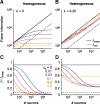The effect of noise correlations in populations of diversely tuned neurons
- PMID: 21976512
- PMCID: PMC3221941
- DOI: 10.1523/JNEUROSCI.2539-11.2011
The effect of noise correlations in populations of diversely tuned neurons
Abstract
The amount of information encoded by networks of neurons critically depends on the correlation structure of their activity. Neurons with similar stimulus preferences tend to have higher noise correlations than others. In homogeneous populations of neurons, this limited range correlation structure is highly detrimental to the accuracy of a population code. Therefore, reduced spike count correlations under attention, after adaptation, or after learning have been interpreted as evidence for a more efficient population code. Here, we analyze the role of limited range correlations in more realistic, heterogeneous population models. We use Fisher information and maximum-likelihood decoding to show that reduced correlations do not necessarily improve encoding accuracy. In fact, in populations with more than a few hundred neurons, increasing the level of limited range correlations can substantially improve encoding accuracy. We found that this improvement results from a decrease in noise entropy that is associated with increasing correlations if the marginal distributions are unchanged. Surprisingly, for constant noise entropy and in the limit of large populations, the encoding accuracy is independent of both structure and magnitude of noise correlations.
Figures












Similar articles
-
Effects of noise correlations on information encoding and decoding.J Neurophysiol. 2006 Jun;95(6):3633-44. doi: 10.1152/jn.00919.2005. Epub 2006 Mar 22. J Neurophysiol. 2006. PMID: 16554512
-
Stimulus-dependent variability and noise correlations in cortical MT neurons.Proc Natl Acad Sci U S A. 2013 Aug 6;110(32):13162-7. doi: 10.1073/pnas.1300098110. Epub 2013 Jul 22. Proc Natl Acad Sci U S A. 2013. PMID: 23878209 Free PMC article.
-
The effect of correlated neuronal firing and neuronal heterogeneity on population coding accuracy in guinea pig inferior colliculus.PLoS One. 2013 Dec 16;8(12):e81660. doi: 10.1371/journal.pone.0081660. eCollection 2013. PLoS One. 2013. PMID: 24358120 Free PMC article.
-
Correlations and Neuronal Population Information.Annu Rev Neurosci. 2016 Jul 8;39:237-56. doi: 10.1146/annurev-neuro-070815-013851. Epub 2016 Apr 21. Annu Rev Neurosci. 2016. PMID: 27145916 Free PMC article. Review.
-
Coding properties of spiking neurons: reverse and cross-correlations.Neural Netw. 2001 Jul-Sep;14(6-7):599-610. doi: 10.1016/s0893-6080(01)00053-3. Neural Netw. 2001. PMID: 11665756 Review.
Cited by
-
Correlated activity supports efficient cortical processing.Front Comput Neurosci. 2015 Jan 6;8:171. doi: 10.3389/fncom.2014.00171. eCollection 2014. Front Comput Neurosci. 2015. PMID: 25610392 Free PMC article.
-
A neural basis of probabilistic computation in visual cortex.Nat Neurosci. 2020 Jan;23(1):122-129. doi: 10.1038/s41593-019-0554-5. Epub 2019 Dec 23. Nat Neurosci. 2020. PMID: 31873286
-
Single-cell optogenetics reveals attenuation-by-suppression in visual cortical neurons.bioRxiv [Preprint]. 2024 May 21:2023.09.13.557650. doi: 10.1101/2023.09.13.557650. bioRxiv. 2024. Update in: Proc Natl Acad Sci U S A. 2024 Nov 5;121(45):e2318837121. doi: 10.1073/pnas.2318837121. PMID: 37745464 Free PMC article. Updated. Preprint.
-
Visual stimulus structure, visual system neural activity, and visual behavior in young human infants.PLoS One. 2024 Jun 18;19(6):e0302852. doi: 10.1371/journal.pone.0302852. eCollection 2024. PLoS One. 2024. PMID: 38889176 Free PMC article.
-
Subthreshold variability of neuronal populations driven by synchronous synaptic inputs.bioRxiv [Preprint]. 2025 Mar 16:2025.03.16.643547. doi: 10.1101/2025.03.16.643547. bioRxiv. 2025. PMID: 40161748 Free PMC article. Preprint.
References
Publication types
MeSH terms
Grants and funding
LinkOut - more resources
Full Text Sources
